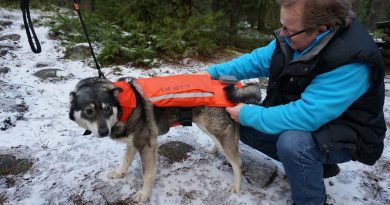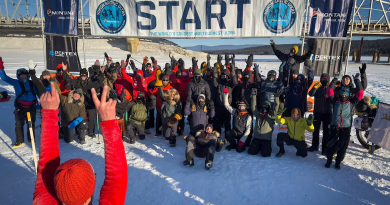Alaska pilots face urban wildlife threat from musk ox
 Tony Gorn sometimes finds himself herding animals near Nome. However, the small town of about 3,500 people on Alaska’s Seward Peninsula isn’t a farming community.
Tony Gorn sometimes finds himself herding animals near Nome. However, the small town of about 3,500 people on Alaska’s Seward Peninsula isn’t a farming community.
Gorn, an area biologist with the Alaska Department of Fish and Game, is herding musk oxen.
“They’re pretty moveable,” Gorn said. “If you get them on the open tundra, get them to stand up and get them walking in the right direction, it’s a lot like moving some cattle.”
For the first time, Nome — a town famous for its turn-of-the-century Gold Rush and the finish line of the Iditarod Trail Sled Dog Race — is having growing pains over urban wildlife in the form of an 800-pound Ice Age ungulate.
Pleistocene-era remnants
More closely related to goats and sheep than oxen, musk ox look like creatures out of magical children’s story. They stand between four to five feet tall. Curved horns peak out below furry back humps. Long, brown hair drapes over their bodies, almost brushing the ground. Beneath thick guard hair is soft undercoat known as qiviut, prized for its extreme warmth. The animals, which migrated to North America during the Pleistocene era, are considered a contemporary of the woolly mammoth.
Gorn is concerned that as more and more musk ox creep into the town, the animals could end up on the Nome Airport runway.
This time of year — from August to October — may be the most dangerous as Nome sees less and less daylight in the weeks before snowfall forces musk oxen into hills.
Gorn, a pilot himself, said the danger of that, should an airplane collide with the animal, could be catastrophic.
Animals everywhere
Vic Olsen has been flying in Nome since 1976. Like many Nome residents, Olsen has seen more musk oxen in the area. Reports of dogs being attacked by the animals are increasing. A German Shepherd was recently left with a gash in his chest after musk ox charged him in early August. At least five dogs were gored last year, according to the Nome Nugget. Wounds from the musk ox could penetrate vital organs and be fatal.
While he’s never had a musk ox near-miss on the runway, Olsen has noticed strange scrapings on airplanes parked near the Nome Airport. Lift struts, which support airplane wings, have been found bent. While he’s not sure musk oxen are the culprits, tracks around the planes suggest they are.
Olsen has hit many birds in his years as a pilot, but he’s never slammed into a large mammal on a runway. A small airplane might be able to dodge a musk ox, but it’s still a concern.
“They’ve never been a problem to me, they’ve never ran out in front of me or threatened my airplane,” he said. “(Nonetheless), it certainly is a possibility.”
Claudia Ihl has studied musk oxen in the area for years as an assistant professor of biology at the University of Alaska Fairbanks Northwest Campus in Nome. She’s flown out of town, looked down and seen musk oxen “right next to the runway.”
About 2,200 musk oxen roam the Seward Peninsula, she said, about 200 of which live in and around Nome. During the winter they head up into the mountains around town, but during the summer move back onto the coastal plane Nome occupies.
With no natural predators nearby and hunting limited in the area, Ihl said the animals feel safe near the city.
And they tend to be stubborn critters. Ihl said some villages have had trouble trying to move them out of graveyards. Pushing the animals out is usually in vain; they tend to return.
“Musk ox are conservative,” she said. “If they find one place they will stick to it until the get what they need.”
A musk ox hunt is relatively new, Gorn said. In 1997 there was a vocal push from residents to not hunt musk ox in the area. Residents wanted to preserve an opportunity to view a unique animal in the wild. Nome, it turns out, is one of the few places in the world people can drive to see wild musk oxen.
Back then, seeing a musk ox meant a 20-to-30-mile trip out of town. Today, Gorn said he sometimes wakes up to the animals eating his wife’s garden.
Precautions in place
Alaska Department of Transportation Northern Region Spokeswoman Meadow Bailey said it’s rare for a musk ox to wander onto Nome’s runway, but there are about five instances of moving the animals every year.
Wildlife managers across the country deal with animals at airports, often birds and deer. But Alaska’s wilderness runways may see heftier animals — moose, caribou, bears and now musk ox — that pose a weightier problem.
The Federal Aviation Administration keeps a database of animal strikes since 1990. While the large majority of wildlife hit by planes every year are birds, the database lists everything from green iguanas to skunks.
In that time, there have been five collisions with moose in Alaska, two with caribou and five with black-tailed deer. There is no listing for musk oxen.
Still, the Nome Airport takes wildlife collisions seriously. It’s part of the Wildlife Hazard Management Program, a joint program with the U.S. Department of Agriculture (USDA) Wildlife Management and the state Department of Transportation.
Bailey called the program “aggressive.” Airport staffers sweep for wildlife, including birds, before every departure. They make attempts to run the animals off before deploying a variety of scare tactics like firecrackers and Tasers. At night, the runway is lit. If a musk ox is spotted in the area, pilots are warned via radio before taking off or landing. If all other options fail, airport officials will kill the animal.
Jeremy Worrall, Department of Transportation northern region aviation manager, said they work to keep the area free of grasses the animals eat and getting rid of standing water animals could use as a watering hole.
How about a fence?
An electric fence around the runway has been used in the past and permanent fencing has been suggested, but permafrost and snow could make it impractical, Worrall said.
There are no easy answers to keeping wildlife off Alaska runways, according to Terry Smith, district supervisor for USDA Wildlife Services in Palmer. Smith hasn’t worked with the musk ox in Nome, but he said similar problems arise with caribou herds on the North Slope. A lot of it just comes down to “herding and babysitting” the animals.
“There’s no silver bullet,” he said. “Persistence and consistency is key.”
Population in flux
Musk oxen were extinct in Seward Peninsula until they were reintroduced in the 1970s and ’80s.
The population grew about 14 percent annually until 2000, Gorn said. But from 2000 to 2007 that growth slowed before flat-lining until 2010. Then the population dropped 24 percent from 2010 to 2012.
The reasons behind the reversal are unclear. Gorn said the number of babies being added to the population have decreased, but pregnancy rates remain high. Gorn doesn’t have research to show if that’s translating into calves being born — or how many of the calves survive.
Gorn noted it may be impossible to completely avoid animal encounters.
“It’s impossible to make Anchorage a moose-free zone,” he said. “All you have to do is respond.”
Ihl said it’s rare to see a musk ox close to an urban area like Nome. They are remote creatures who usually live in areas without human populations.
But she said residents on Nunivak Island, who were experiencing structural damage from the animals in the 1930s, countered the influx by hunting them. Eventually, the animals learned to stay away from the population centers.
“It’s not going to happen over night,” she said. “That awareness has to trickle down a few generations.”
Contact Suzanna Caldwell at suzanna(at)alaskadispatch.com
For more stories from Alaska Dispatch, click here



